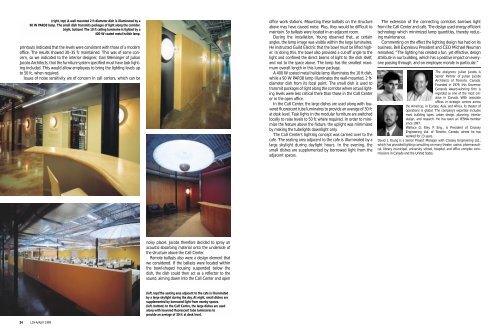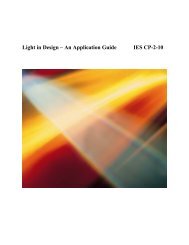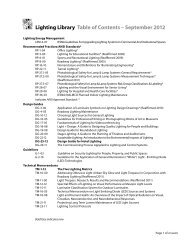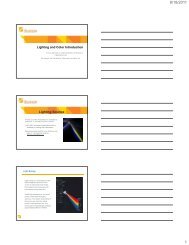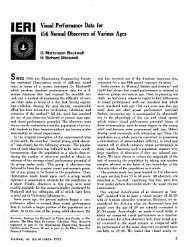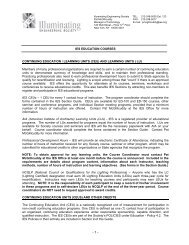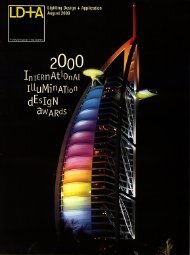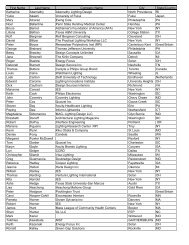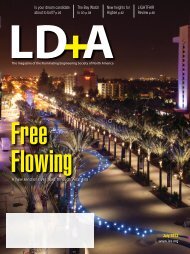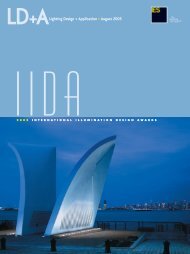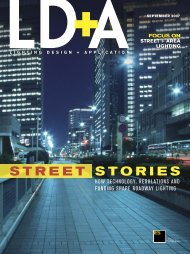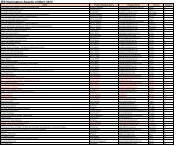lightfair international - Illuminating Engineering Society
lightfair international - Illuminating Engineering Society
lightfair international - Illuminating Engineering Society
You also want an ePaper? Increase the reach of your titles
YUMPU automatically turns print PDFs into web optimized ePapers that Google loves.
(right, top) A wall mounted 2 ft diameter dish is illuminated by a<br />
90 W PAR38 lamp. The small dish transmits packages of light along the corridor.<br />
(right, bottom) The 10 ft ceiling luminaire is lighted by a<br />
400 W coated metal halide lamp.<br />
printouts indicated that the levels were consistent with those of a modern<br />
office. The results showed 30–35 fc maintained. This was of some concern,<br />
so we indicated to the interior designer, Gail Weininger of Julian<br />
Jacobs Architects, that the furniture system specified must have task lighting<br />
included. This would allow employees to bring the lighting levels up<br />
to 50 fc, when required.<br />
Issues of noise sensitivity are of concern in call centers, which can be<br />
office work stations. Mounting these ballasts on the structure<br />
above may have caused noise. Plus, they would be difficult to<br />
maintain. So ballasts were located in an adjacent room.<br />
During the installation, Young observed that, at certain<br />
angles, the lamp image was visible within the large luminaires.<br />
He instructed Guild Electric that the bowl must be lifted higher.<br />
In doing this, the bowl also provided a cut-off angle to the<br />
light and confined the direct beams of light to the dish itself,<br />
and not to the space above. The lamp has the smallest maximum<br />
overall length in this lumen package.<br />
A 400 W coated metal halide lamp illuminates the 10 ft dish,<br />
while a 90 W PAR38 lamp illuminates the wall-mounted, 2 ftdiameter<br />
dish from its focal point. The small dish is used to<br />
transmit packages of light along the corridor where actual lighting<br />
levels were less critical there than those in the Call Center<br />
or in the open office.<br />
In the Call Center, the large dishes are used along with louvered<br />
fluorescent tube luminaires to provide an average of 30 fc<br />
at desk level. Task lights in the modular furniture are switched<br />
locally to raise levels to 50 fc where required. In order to minimize<br />
the feature above the fixture, the uplight was minimized<br />
by making the tubelights downlight only.<br />
The Call Center’s lighting concept was carried over to the<br />
cafe. The seating area adjacent to the cafe is illuminated by a<br />
large skylight during daylight hours. In the evening, the<br />
small dishes are supplemented by borrowed light from the<br />
adjacent spaces.<br />
The extension of the connecting corridors borrows light<br />
from the Call Center and cafe. The design used energy efficient<br />
technology which minimized lamp quantities, thereby reducing<br />
maintenance.<br />
Commenting on the effect the lighting design has had on its<br />
business, Bell Expressvu President and CEO Michael Neuman<br />
remarked, “The lighting has created a fun, yet effective, design<br />
attribute in our building, which has a positive impact on everyone<br />
passing through, and on employee morale in particular.”<br />
The designers: Julian Jacobs is<br />
Senior Partner of Julian Jacobs<br />
Architects of Toronto, Canada.<br />
Founded in 1979, this Governor<br />
General’s Award-winning firm is<br />
regarded as one of the most creative<br />
in Canada. With associate<br />
offices in strategic centers across<br />
the Americas, in Europe, Asia, and Africa, its theater of<br />
operations is global. The company’s expertise includes<br />
most building types, urban design, planning, interior<br />
design, and research. He has been an IESNA member<br />
since 1997.<br />
Wallace G. Eley, P. Eng., is President of Crossey<br />
<strong>Engineering</strong> Ltd. of Toronto, Canada, where he has<br />
worked for 23 years.<br />
David J. Young is a Senior Project Manager with Crossey <strong>Engineering</strong> Ltd.,<br />
which has provided lighting consulting on many theater, casino, pharmaceutical,<br />
library, municipal, university, school, hospital, and office complex commissions<br />
in Canada and the United States.<br />
noisy places. Jacobs therefore decided to spray an<br />
acoustic-absorbing material onto the underside of<br />
the structure above the Call Center.<br />
Remote ballasts also were a design element that<br />
we considered. If the ballasts were located within<br />
the bowl-shaped housing suspended below the<br />
dish, the dish could then act as a reflector to the<br />
sound, aiming down into the Call Center and open<br />
(left, top)The seating area adjacent to the cafe is illuminated<br />
by a large skylight during the day. At night, small dishes are<br />
supplemented by borrowed light from nearby spaces.<br />
(left, bottom) In the Call Centre, the large dishes are used<br />
along with louvered fluorescent tube luminaires to<br />
provide an average of 30 fc at desk level.<br />
34 LD+A/April 1999


